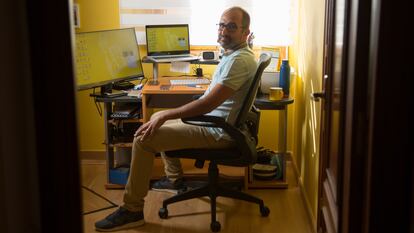In Spain, the return to the office pits defenders and detractors of remote work against one another
Some experts predict pay cuts and fewer promotions for employees who move to cheaper locations, but surveys show that many workers are willing to sacrifice salary for quality of life

Few have been more vocal than James Gorman, CEO of Morgan Stanley, when it comes to speaking out against working from home. “If you can go to a restaurant in New York, you can come to the office, and we want you in the office,” he has said. As the head of one of Wall Street’s largest investment banks, he has given his employees until September 6, Labor Day in the US, to wend their way voluntarily back to their desks. Otherwise, he promises they will be having “another kind of conversation.”
Gorman’s tone at a conference with investors on June 14 was nothing if not blunt, and surely not the most motivating way to encourage staff to put months of labor flexibility behind them. But two of his arguments go straight to the heart of the debate that is poised to erupt over remote work, the first of which concerns wages. “If you want to be paid a New York wage, you work in New York,” he says. “There’s no question of being in Colorado and getting paid like you live in New York. Sorry. That doesn’t work.” The second point concerns professional growth. “Make no mistake; we do our work in Morgan Stanley’s offices. That’s where our interns learn, and that’s how we train people.”
Given that every country takes location into account when it comes to salaries, the dilemma to which Gorman alludes is universal. Will Madrid salaries, which currently stand at an average of €27,817, be paid to those who move to the Canary Islands where the average is €20,861 and where Zoom meetings can be conducted with a sea view? Will internships in companies be as worthwhile if the young newcomers do not see how their colleagues and bosses work?
Not only is it possible that some workers won’t want to go back to the office, we now have a lot of data showing that there is a willingness to take big pay cuts to avoid having to do soTessa West, NYU associate professor of psychology
Ignacio de la Torre, chief economist at the investment bank Arcano and chairman of the Círculo de Empresarios business association’s advisory board, believes it is likely that salaries will be reduced if staff decide to relocate to cheaper destinations. “If you work at Facebook and you move to El Burgo de Osma [a small Spanish village in Soria province], it won’t take long for your boss to tell you that he’s adjusting your salary,” he says. “He’s not going to pay you the same as if you lived in Palo Alto. He may even think about hiring someone who works for less from Argentina.”
The real litmus test will come in September when more than 70% of the population should be vaccinated in Spain and other EU countries. At that point, there will be three alternatives: 100% remote work, a hybrid system or 100% on-site.
According to De la Torre, remote working will be a last resort. First, because many sectors, such as the hospitality industry, depend on face-to-face activity. Second, because “life teaches you that physical proximity is conducive to networking [contacts, agenda] while productivity and creativity require a physical presence,” he says. “Silicon Valley or MIT [Massachusetts Institute of Technology] are physical proximity ecosystems. It’s not possible to achieve the same productivity with teleworking.”
Lastly, there is the fear of being left out. “If your co-workers return and you don’t, you’re going to get scared,” he says. “You may feel like things aren’t happening around you. There are studies that show that the teleworker demographic accounts for just half the promotions of those who come in person.”
Companies with a strong corporate culture, such as Goldman Sachs, have recently asked their employees to return to the office. And the position of its CEO, David Salomon, was made clear when he called telecommuting “an aberration that needs to be corrected as soon as possible.” Jamie Dimon, the superboss of JP Morgan, America’s largest bank, is not about to embark on a telecommuting revolution either. Although he is willing to allow it for 10% of his US workforce – 25,000 out of 255,000 employees – he is far from enthusiastic, especially after some clients told him that they switched to a competitor because their staff visited them face-to-face while those at JP Morgan were still online. “It’s a lesson,” Dimon remarked ruefully.

Meanwhile, Liberty Seguros – an international subsidiary of Boston-based Liberty Mutual Group – is opting for the opposite approach. Its nearly 2,000 European employees can work from home for 100% of their working day if they wish, or come into the office just two days a week. The initiative has the support of 99% of the workforce, according to an internal survey. As part of the package, there are meal tickets, a €460 check to help staff set up teleworking spaces and an extra monthly payment of €55 to cover other expenses. Beatriz Ortega, head of Employee Experience at the firm, maintains that the decision has been win-win: on the one hand, it allows the firm to attract talent from any city in Spain; and on the other, it has improved the lives of their staff. “We have colleagues who have changed their location to live closer to their family or simply because they prefer to live in smaller cities or areas with a better climate,” she says.
Jesús González, who works in the Liberty Seguros communications department and lives in Salamanca, is among them. In November 2019, he swapped Madrid for Segovia when he learned that the company was planning a pilot project that would allow him to work from home for at least several days a week. Both he and his partner, also a Liberty employee, were tired of the noise and prices in the capital. “We had been living in Madrid for a long time and when they raised our rent, we decided to try Segovia,” he says.
The decision was risky. At first, the teleworking initiative was still to be established and it took them an hour and a half to get from their front door to the office. They left at 7am and returned at 7pm. But when the pandemic confined them to their home, their company accelerated the initiative’s timeline. “It saves me time, money and headaches, because we also had a baby in April during the confinement,” says González, who is expecting a second child with his partner. “When it comes to reconciling work and family life, there is no comparison; in other circumstances, I would have seen the child for an hour a day. Now I can help at home and give him a feed. I don’t see any drawbacks to the system, although I suppose it depends on your personal circumstances.”
The couple exchanged their expensive rent in Madrid for a mortgage on a more spacious home. “Segovia is a much friendlier, more manageable and a smaller city,” he says. “In Madrid, we paid €850 a month in rent. Now we have a mortgage of €520 for an apartment three times bigger than the one in Madrid, with 130 square meters.” González also now saves on the €200 a month AVE pass and €50 a month Metro pass, and does not believe that the lack of interaction with his office colleagues deprives the company of new ideas, given that his main meetings are online with colleagues in Ireland and Portugal.
Aware of the need for a break from the screen, Liberty Seguros goes even further and allows a more relaxed format in some of its weekly meetings, encouraging its employees to connect while taking a walk with headphones and a microphone.
At the Spanish digital consultancy firm atSistemas, its 1,600 workers are not only encouraged to stay at home, but also to choose their schedule according to their needs. “Work is no longer a specific location or schedule,” the company states. Its strategy director, Antonio Chamorro, believes the approach will improve productivity, reduce absenteeism and create the ideal working environment.
But the Liberty and atSistemas’ approach is not the norm. Rather, a hybrid option is the most popular among larger firms in Spain. An Adecco survey notes that 44% favor the two-day-a-week remote option and 29% have gone for the one-day remote option. Sources at Santander Bank explain that just over half of its staff work on-site at its corporate centers in Spain. The bank says it is opting for a “hybrid and flexible” model that takes advantage of the benefits of working remotely, although it continues to promote face-to-face work and is ironing out the details of how to organize itself, drawing on “active listening.”
The second-largest Spanish bank, BBVA, explains that since July 2020 it has implemented “a hybrid model of a voluntary nature,” which it is in favor of maintaining once the health crisis is over. Most of the major financial institutions are thinking along similar lines, seeing the approach as an acceleration of a pre-pandemic trend rather than a break with the pre-pandemic past. The Spanish communications giant Telefónica has proposed a voluntary two days of remote working a week to 10,000 of its 21,000 employees in Spain. In a recent interview with the US network CNN, its CEO, José María Álvarez-Pallete, defended its flexible approach while rejecting more drastic measures such as shedding office space. “You can’t be entirely telecommuting in the long term,” he said.
Reluctance to return to the office
Although there is a wide disparity in figures, surveys show that a large percentage of Spaniards want to work from home for at least several days a week. And although salary is still a key factor, work-life balance is gaining ground.
Brighite Paita, a 23-year-old computer programmer from Extremadura, has been teleworking since the pandemic began, but her company has already sent an email out to inform staff of a staggered return. Paita isn’t keen. She hasn’t saved enough money to buy a car, and getting from Almendralejo to Mérida on public transit is an ordeal. When she used to go to the office, she would get home at 7pm. Now she works intensively until 3pm, allowing her time to exercise. A return to the office will mean no gym at the end of the day and Sundays spent cooking for the rest of the week. “I can do the work exactly the same from home,” she says. “My partner has been offered the option of working from home by his company.”
Psychologist Tessa West, an associate professor of psychology at New York University and author of the book Jerks At Work: toxic coworkers and what to do about them, predicts that many companies will wrestle with finding the right balance and keeping everyone happy. “Not only is it possible that some workers won’t want to go back to the office, we also now have a lot of data showing that there is a willingness to take big pay cuts to avoid having to do so,” she says. “Not only are bosses having conflicts with their employees but there are also disagreements among the higher echelons about how to handle the resistance.” West suggests having an open conversation. “Employees need to be honest about what their concerns are, and their managers need to ask them. They can’t assume that everyone is anxious about the same thing: some people are anxious about things like small talk and eye contact, while others are anxious about the possibility of getting sick.”
Chema Martínez, secretary general of the services division at Spain’s Comisiones Obreras (CCOO) labor union, says that although there is now more of a remote-work culture than in the past, there is no real commitment being made to organizing it properly, with the biggest conflicts triggered by the reluctance of companies to cover expenses for home use of the internet, electricity or water. “There is an element of managers having been trained for on-site work,” he says. “Workforces are being urged to return to their posts.”
According to Álvaro Vicioso, secretary for union action at the General Union of Workers (UGT), Spain’s other major labor union, the mass return to the office scheduled for September and October is causing a lot of uncertainty. “There are workers who want to return and companies putting obstacles in their way, while there are others who are afraid of catching the disease on the way to work or in the company itself because they are not sure appropriate measures have been taken, as happens in jobs with a high density of personnel such as telemarketers,” he says.
The CEOE employers association highlights the positive aspects of working from home, a practice that was regulated by law in Spain last September. Moreover, “it leads to an increase in productivity, which is also improved by the implementation of a goal-oriented work culture, reducing the need for face time, which leads to lower efficiency.” They also point out its benefits for people with reduced mobility, for attracting workers to rural parts of Spain with low population density, for the environment, and for its impact on reducing accidents on the way to work.
José Luis Casero, president of the Committee for the Rationalization of Spanish Schedules (ARHOE), points out that what happened during the pandemic has not been teleworking, but a kind of “every man for himself” situation, enforced by the health emergency. He considers that the companies that use the new work model in a regulated manner will emerge stronger. “Those that believe that it is enough to plant a computer anywhere and have the worker 100% available under the premise that ‘since they are at home…’ are going to get it wrong and are going to get their fingers burned,” he says. In any case, as he points out, it’s not an all-or-nothing scenario; from time to time it will be necessary to be in the office. “Teleworking can slide into a remote face-time situation that supposes the worker is connected from 9am to 9pm,” he says. “It can degenerate into a pajama syndrome – workers who don’t shave or shower, and spend all day in sweatpants. We are human beings, we need interaction; but if you ask young people, they want freedom regarding space and time. They are not afraid of goal-based work, which is why we are 100% in favor of partial teleworking, but with investment in technology and training, without improvisation.”
Of course, there are those who prefer the office and those who prefer working from home. Those who want to get back to the office complain about the lack of space at home, uncomfortable chairs, noise from children or neighbors, the need to disconnect and a feeling of isolation. Those who want to stay home highlight the benefits of spending more time with the family, with their pets, eating a home-made lunch, saving time and money on travel and having the opportunity to do more exercise. But, except in specific cases, it seems that the majority will have to be satisfied with a cocktail of both.
English version by Heather Galloway.
Tu suscripción se está usando en otro dispositivo
¿Quieres añadir otro usuario a tu suscripción?
Si continúas leyendo en este dispositivo, no se podrá leer en el otro.
FlechaTu suscripción se está usando en otro dispositivo y solo puedes acceder a EL PAÍS desde un dispositivo a la vez.
Si quieres compartir tu cuenta, cambia tu suscripción a la modalidad Premium, así podrás añadir otro usuario. Cada uno accederá con su propia cuenta de email, lo que os permitirá personalizar vuestra experiencia en EL PAÍS.
¿Tienes una suscripción de empresa? Accede aquí para contratar más cuentas.
En el caso de no saber quién está usando tu cuenta, te recomendamos cambiar tu contraseña aquí.
Si decides continuar compartiendo tu cuenta, este mensaje se mostrará en tu dispositivo y en el de la otra persona que está usando tu cuenta de forma indefinida, afectando a tu experiencia de lectura. Puedes consultar aquí los términos y condiciones de la suscripción digital.
Últimas noticias
Most viewed
- Sinaloa Cartel war is taking its toll on Los Chapitos
- Oona Chaplin: ‘I told James Cameron that I was living in a treehouse and starting a permaculture project with a friend’
- Reinhard Genzel, Nobel laureate in physics: ‘One-minute videos will never give you the truth’
- Why the price of coffee has skyrocketed: from Brazilian plantations to specialty coffee houses
- Silver prices are going crazy: This is what’s fueling the rally









































